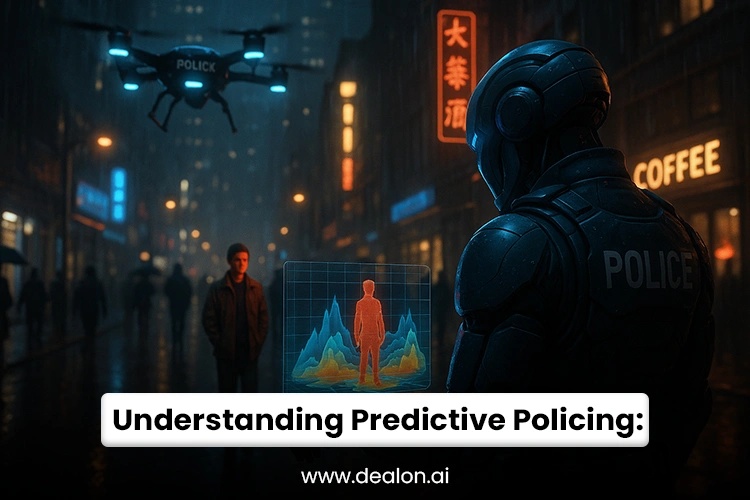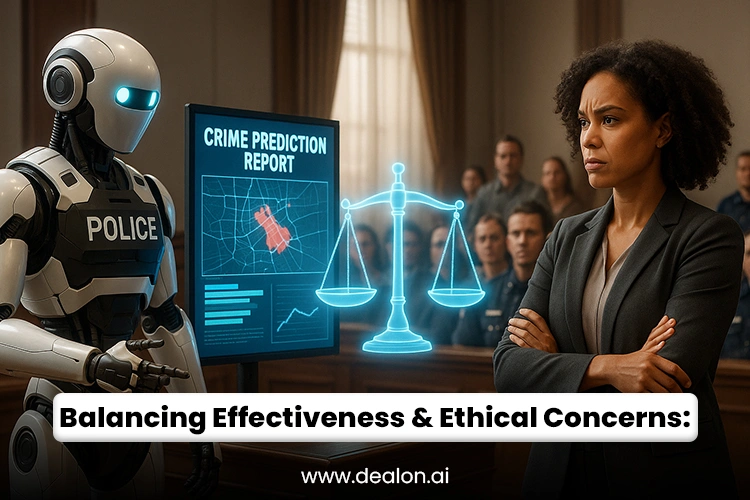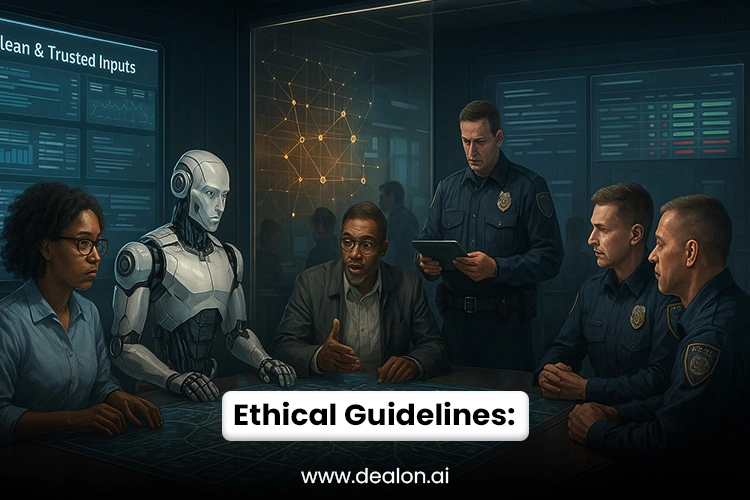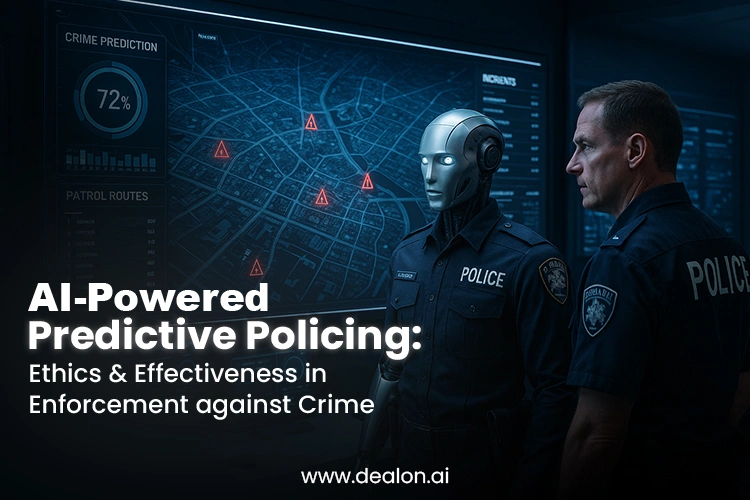AI is starting to influence different industries, and law enforcement is leading the charge. Predictive policing is a new and widespread use of AI to predict crime before it happens, although it can also be controversial. Using information from past crimes, demographics, and different economic aspects, predictive policing helps law enforcement groups better use their resources, find places where crime is likely, and try to stop criminal acts. Please keep in mind that even though this technology helps us with precise and efficient operations, there are still significant ethical challenges we should consider.
The central problem is the fairness and bias in how these systems deal with data. Several critics point out that relying on policing could lead to increased inequalities for communities on the margins. There is also some doubt about how effective AI-driven crime predictions are in reducing criminal activity.
Understanding Predictive Policing: Looking at the Pioneering Use of AI in the Police Force

Policing uses AI to analyze multiple forms of information to predict forthcoming crimes. They bring together various data sources, such as records of past crimes, population counts, types of weather, and trends in the economy. Machine learning algorithms analyze data to identify locations where crimes may happen and individuals likely to engage in such activities. As a result, law enforcement agencies can deploy their resources to places where crimes may happen rather than wait until after the fact.
Predictive policing is innovative because it keeps learning as new data comes in. Traditional strategies may not change, but AI systems improve their judgments in response to live facts as they happen, helping them follow changing crime trends. The idea is that, with practice, this type of learning will make police forecasts more precise and let them use fewer resources.
While it can be very beneficial in fighting crime, it also presents several issues. Using past statistics in forecasting can introduce bias into the process. If the information used to train the AI comes from past racial profiling or over-policing in some neighborhoods, the AI could end up perpetuating those inequalities. Moreover, how well forecasts are made relies significantly on having high-quality data, which can still lead to mistakes.
Predictive policing can raise ethical questions, mainly due to the possible infringement on citizens’ rights when not fully justified. When integrating AI into policing, making sure it is used honestly and responsibly helps ensure law enforcement is fair as well as helpful to the public.
Also Read: 6 Ways AI Can Improve Your Website’s SEO and Search Performance
The Ethical Dilemma: Bias and Discrimination Found in AI Algorithms
There is an important ethical issue with AI in predictive policing, since it could further reinforce societal biases. By studying past data, AI identifies possible crime locations and who might be involved. However, if the data used to train the AI contains patterns of racial profiling, differing wealth levels, or geographical discrimination, the system will reflect this in its answers. As a result, there are significant fears that this could lead to more bias and inequality in law enforcement.
As an example, predictive police tools may designate communities with poverty and a high minority population as being at greater risk of crime. This often leads law enforcement to deploy more effort and staff in those neighborhoods. This further marginalizes specific communities and can result in a situation where people in those groups are more likely to be arrested because of extra surveillance, which again strengthens the algorithm’s prediction. Such a cycle can lead to increased mistrust between law enforcement and community members who have experienced historical injustice.
In addition, many predictive policing algorithms are kept private, so they are not easy to check by the public. Most of the public, including policymakers, cannot understand the decisions made by AI systems, which has made accountability a concern. If decisions are kept secret, addressing and resolving any inequalities in the outcomes becomes tough. This lack of transparency undermines our constitutional right to justice and civil rights, since it is tougher to vet this policing for fairness and equal treatment.
Because of hidden bias, inequity, and unclear design in predictive policing, we should consider how AI is used in policing and improve it from both a technology and ethical perspective to prevent increasing social inequalities.
Balancing Effectiveness and Ethical Concerns: Can Predictive Policing Be Fair?

Though there are serious concerns about ethical issues in predictive policing, the technology can improve efforts to stop crimes. When AI is fed lots of data, it can uncover crime patterns that are difficult for policemen to spot and help better direct resources. This way of using data can prevent crimes from happening in the first place, which helps reduce the justice system’s workload and boosts public safety.
Yet, the value of this police work depends greatly on how good the data fed into it is. For AI to help, it should be trained using data that is accurate and completely free from biases. Where the data shows historical unfairness, such as repeating acts of unfair policing, the AI may continue those injustices and increase existing unequal treatment. That’s why checking and correcting data used to train models is crucial to ensure they are not biased. The possible risks outweigh the potential gains if AI systems are not appropriately curated.
Predictive policing can assist police officers in their work, but should not be used to replace their judgment entirely. The final say in law enforcement should not be made by AI alone. Law enforcement officers should use both human reasoning and AI information while respecting what is right and wrong. Being guided by human decision-making helps stop those in charge from using AI-generated predictions in a way that affects people’s rights or inconveniences certain groups.
Experts in predictive policing believe that once AI systems are careful and used responsibly, they can help reduce bias in law enforcement decisions. Applying the same response to common crimes across the board could guarantee that all areas are treated equally by the law enforcement system, regardless of their demographics. For this to happen, ethics in policing, clarity in the process, and being answerable must be present at every step of creating and using predictive law enforcement technology.
A good and fair police force is built by keeping pace with technology and by upholding human rights. It is essential to keep watch over this technology, update its algorithms, and actively engage many people to help avoid it harming people. For predictive policing to help a society, we must ensure it is innovative and ethical.
Case Studies: Looking at How Predictive Policing Affects Communities
PredPol is one of the best-known predictive policing tools in places like Los Angeles and Oakland. It examines information about past crimes to try to spot patterns that might show where burglary or robbery could happen in the future. Some argue that predictive policing has led to less crime, since police can better use their resources by targeting areas where crime is most likely. Even so, PredPol has encountered a lot of criticism, mostly about whether the data it works with is correct and fair.
It has been argued that by using information from older crimes, the tool can perpetuate unfairness and uneven policing towards minority groups. When crime in ethnic minorities’ districts is reported to be more frequent, the surveillance and arrest of people in those areas may continue instead of changing what is causing the crime in the first place. Consequently, the question is raised as to whether these technologies add to social inequality instead of helping to solve it.
The Chicago Police Department also used the Strategic Subject List (SSL), an AI system meant to identify those more likely to be exposed to gun violence. Looking at a person’s criminal background, connections, and social circles, the SSL tried to deal with the issue early and thus prevent violence and save lives. At the same time, the program has received many criticisms since it targets Black and Latino individuals using questionable factors.
It was discovered that the system tended to point out people from these communities as potential threats, disregarding other factors that said they were unlikely to be violent. As a result, individuals began to worry about racial profiling and how these technologies could be misused. Some argued that it might not work against violence and could also lead to increased tension between the police and minorities.
The two cases highlight how predictive policing can have good and bad effects. On one side, the technology supports crime prevention and efficient management of resources, but on the other side, it can bring ethical issues. Predictive tools should be created and used without bias so they do not unknowingly maintain the problems they are meant to solve. When law enforcement keeps improving, they should pay attention to ethics and maintain accountability within the systems.
Moving Forward: Ethical guidelines and best ways to practice predictive policing

As such systems are more widely adopted by law enforcement, setting up a way to make sure they are effective and ethical is very important. While AI can highly impact crime rates and the use of resources, it should be put to use only after taking its fairness and transparency into account. To ensure predictive policing positively impacts society, law enforcement should follow guidelines for equal treatment, public trust, and accuracy in their predictions.
1. Improve Data Quality
Data analysis is the basis of every predictive policing system. If the data used to train AI is of the highest quality and unbiased by historical issues, it will help the AI predict accurately and with fairness. Regularly checking the data sources is essential to ensure the information is correct and complete. As a result, crime records should be updated and include various factors about people, society, and areas to reflect better the situations surrounding the crimes. Also, getting rid of any information that might lead to racial profiling or unequal law enforcement in various neighborhoods helps avoid the continuation of discrimination.
2. Enhance transparency
Law enforcement needs to be transparent about its actions to earn public trust when using AI. The developers must explain the system’s logic, and all the necessary data should be given. It explains the reasoning behind the AI’s predictions and the various steps it takes to make a choice. Making the decision-making in predictive policing clear to the public allows them to check on the authorities and help prevent concerns about private algorithms. Openness in government actions encourages trust and will enable citizens to join in and give feedback.
3. Incorporate Human Oversight
AI should always be used as a helping hand, not as a substitute for people’s judgments. Though such systems handle extensive data better than humans, they miss the specific details of individual cases and cannot judge the broader results of their predictions. Due to the context-sensitive nature of AI-generated insights, it is necessary to have a person interpret and implement them. Law officers must learn to think carefully about the reliability of AI, taking ethics and local conditions into consideration when using it. Relying on data models alone may lead to injustice, so people must have a deciding role.
4. Engage with Communities
Communicating with communities affected by predictive policing will support ethical use of the technology. It is important for law enforcement agencies to include people from the community and civil rights groups in all discussions involving predictive policing. By engaging, we make sure that vulnerable communities are heard and their views are taken into account when making decisions. In addition, this helps law enforcement to be more aware of local values and support from the community, which can ease the tension between police and the public.
5. Regular Audits and Accountability
Ultimately, these systems should be regularly reviewed to gauge their effects on different societal groups. Special attention in these audits is given to the correctness of crime predictions and the possibility of the system creating unequal treatment across communities. If auditing shows an unfair bias towards certain racial, ethnic, or socioeconomic groups, the algorithm should be adjusted accordingly. Ensuring law enforcement is held responsible for the results of predictive policing will help prevent it from strengthening existing inequalities.
Conclusion
The use of AI in crime prediction gives law enforcement a chance to direct their resources in a better way and diminish the number of crimes. However, applying AI raises several ethical issues, such as those linked to bias, how transparent the technology is, and how much trust the community has. As we found, using data from the past in AI may lead to racial profiling and social inequality, so we must continually evaluate and remove biases.
Following the best guidelines and using new rules, authorities can deal with the benefits and challenges in this field. Including the public helps ensure that predictive policing systems are designed with the public’s needs in mind. Often, it is important to do regular audits and accountability checks to identify when predictive policing creates unfair treatment and to take appropriate action.
A Good use of predictive policing can be very valuable. Taking measures to fight bias, be more transparent, and follow ethical guidelines helps ensure that AI technologies keep people safe without harming anyone’s rights. The purpose is to control crime and earn public trust in the actions of law enforcement.

